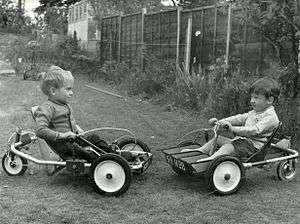Hobcart
A hobcart was a type of mobility device designed in the late 1960s by Dr. Steven Perry of Albrighton, Shropshire, UK. In his practice he had two young children, both of whom had spina bifida. He considered that the wheelchairs the children were provided with were liable to set them apart from other children of their age, so set about designing a mobility device, that would look like a go-kart. The end result was the hobcart, which when it was first made, was produced at a local borstal. The idea behind this was to try to provide the inmates of the borstal the opportunity to be involved in a project which they could see was doing some good. Hobcarts were still being made into the 1980s.

David Smith and John Casey using their Hobcarts in the late 1960s.
References
External links
- Entry in New Scientist Magazine on Hobcarts
- W. Richard Bowen (15 March 2014). Engineering Ethics: Challenges and Opportunities. Springer Science & Business Media. pp. 93–94. ISBN 978-3-319-04096-7.
- Hand Operated Hobcarts (flv) (Television production). ATV Today. 1971-06-12. Retrieved 2014-08-09 – via MACE.
This article is issued from
Wikipedia.
The text is licensed under Creative
Commons - Attribution - Sharealike.
Additional terms may apply for the media files.